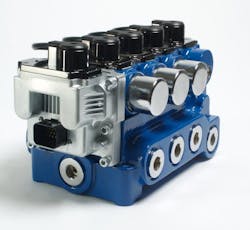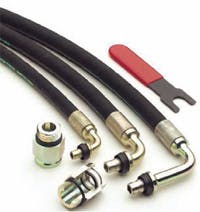McNeilus brand concrete mixers are used by more concrete producers than any other on the market, and McNeilus is also a leading brand in refuse collection vehicles. McNeilus Companies Inc., Dodge Center, Minn., has been able to maintain its industry leadership by regularly introducing design improvement that give a boost to productivity and fuel efficiency.
Some of these recent innovations incorporate a Power-On-Demand (POD) load-sensing hydraulic system from the Hydraulics Group of Eaton Corp., Eden Prairie, Minn. into McNeilus’s ZR Series side-loading refuse collection trucks. The POD technology provides fuel economy by powering up hydraulic pumps and motors strictly to meet system demands. By supplying power only when it is actually needed, a system like Eaton’s Power-On-Demand can dramatically reduce the amount of diesel fuel used by a refuse truck. When paired with Eaton’s Hydraulic Launch Assist hybrid drive system, the fuel savings can reach 25% to 40% compared to traditionally-equipped trucks based on actual field experience.
The POD systems have demonstrated annual fuel savings of $4,000 to $6,000 per truck based on daily fuel savings of 4 to 7 gal per truck and $3 per gal diesel fuel. In addition to fuel savings and increased productivity, the POD systems may be simpler than the traditional hydraulic systems they replace. They can have fewer connections, longer lasting components, and offer increasingly sophisticated opportunities for integration through electronic sensors and controls.
The system used in the ZR Series includes a tandem Eaton 420 Series piston pump, Vickers CMX electrohydraulic load-sense valve, and Vickers MCD manifolds.
Other technologies contributing to the new design include Eaton’s T motors, Integrated Hydraulics’ dual over-center valves, Eaton Snap To Connect (STC) connectors, and Aeroquip GH493 hose assemblies.
The improvements called for sizing pumps to match the required cycle time of packer cylinders, preventing excessive heat generation, and reducing leakage from loose adapters and fittings. Results are impressive: a 20% improvement in productivity and up to 15% improvement in fuel savings compared to similar models
A look at the application
Picking up trash in areas with tight alleyways, narrow streets, or overhead interference has long been a challenge for operators of refuse trucks. But these conditions present opportunities for the ZR Series fulleject automated side loader to really show its stuff.
It features a zero-radius side arm that lifts 30-, 60-, or 96-gal containers vertically up the arm and dumps them into the truck without needing the arm to extend outward into alleys or tight urban right of ways.
Another useful ZR Series feature is its full-eject body that opens the tailgate and uses telescoping cylinders to eject the load without a body tip up or gravity dump. Furthermore, the body’s low center of gravity makes it more stable during landfill dumping operations.
Meeting many challenges
McNeilus called on us in early 2009 with the need for a complete hydraulic system for the new side loader using CANbus controls for optimum performance. McNeilus’s initial thought was to equip the system with traditional fixed-displacement gear pumps, and we responded by specifying hydraulic control valves to complete the system. After evaluating the performance and fuel demands of the prototype hydraulic system on a side-loader during test trials, McNeilus decided to take the road less traveled and equip the truck with a full POD system using piston pumps.
Because the full-eject body is equipped with large telescoping cylinders that run the packing mechanism, the first challenge was to size the pumps to achieve adequate cycle time for the packer cylinders and to fit behind the transmission without interference.
Packer cylinders typically have slow pack extend and retract cycle times due to the high fluid volume required to extend the packing panel during each packing cycle. The trucks are designed for 1,000 to 1,500 lift cycles per day, and the pack panel extends and retracts twice for each lift cycle. Consequently, instances could occur during routes with frequent stops that the packer panel may not stop running. And in some cases, the packer panel might not keep up with the lift circuit, which would increase route time. A large piston pump would provide the flow required. However, its bulky size and cost did not make it an attractive option.
Competitive products equipped on the ZR arm were also causing concerns. A pair of motors on a trolley lift and an over-center valve to control motor movement were wasting energy by generating excessive heat during performance testing. Another problem area was hydraulic fluid leakage due to adapters and fittings that became loose when hoses were extended or twisted during body lift operations.
Full replacements offer system solutions
The truck’s arm ran quickly during its dumping cycle then came to rest, so Eaton’s 420 series pump was specified because it allows the arm and packer to work in tandem while the arm is stationary and the packer is cycling.
While considering pump options, we realized that the arm operated quickly during the garbage can dumping cycle and then came to a rest as the packer panel was still extending and retracting to clear the hopper.
This meant that if the arm pump and packer pump could work in tandem while the arm was stationary and the packer was still cycling, the cycle time would improve dramatically. As a result, we selected a tandem 80-cc Eaton 420 Series pump for the application.
Applying the POD load-sensing technology, we designed a custom Vickers MCD manifold with the capability to combine pump flows during packer extend and run independently when the arm must function, resulting in a dramatic reduction in packer cycle time from 17 to 10 sec. Included in the manifold assembly are Eaton’s Vickers solenoid valves, proportional valves, flow regulators, check valves, shuttle valves, and differential pressure sensing logic elements.
Controlling the loader arm proportionally and smoothly was another circuit requirement that benefited from the POD load-sensing technology. A three-section Vickers CMX 100 electrohydraulic load-sense valve was chosen to run the arm reach, grabber, and trolley lift functions due to its capability to precisely manage proportional flow. Using the valve resulted in faster cycle time with less fatigue on the truck structure, along with improved fuel savings by using full POD technology.
To overcome the excessive heat caused by the motor trolley circuit, we teamed up with Tony Montabon, Eaton’s on-site applications engineer at McNeilus, and partnered with McNeilus engineers to evaluate the arm performance and chose Eaton 8.0 in.3 T motors and Integrated Hydraulics’ dual over-center valves as replacement components. Also specified were Aeroquip GH493 half-bend radius, high-pressure hose assemblies that withstand the tight bend radii required as they move in and out during arm reach. The tightbend radii allowed McNeilus to use larger diameter hose assemblies, resulting in a dramatic reduction in wasted heat, thereby improving the efficiency of the circuit.
The STC threadless adapters were specified in locations in which hoses move while the body lift mechanism is activated. This selection was based on their swivel capability when not under pressure and that they use a snap ring to connect the male with the female, which seals on an O-ring to result in a leak-free connection. This is McNeilus’s first application for STC connectors. They are providing leakfree performance and are easy for assembly line crews to install.
Changes see quick results
The McNeilus ZR Series went into production in May 2010 and is already proving to be the fastest side loader in the industry.
Packer cycle time is typically a factor in how fast an operator can finish a route. On highly dense routes where houses are close together, operators of conventional side loaders often had to wait for the hopper to clear the loading chamber before loading another garbage can. To date, operators have not had to wait for the ZR packer to clear. They just go from can to can without slowing down.
During two test trials, the ZR side-loader finished identical routes in about two hours less than other McNeilus side-loaders. The 20% improvement in productivity is a direct result of the fast arm and packer cycle times achieved by the POD system. Based on previous test results of similar trucks equipped with POD systems, the ZR side-loader also has the potential to save up to 15% on fuel consumption compared to a conventional fixed-displacement gear pump system.
For information on Eaton’s Power On Demand load-sensing hydraulic system, visit www.eaton.com/hydraulics.





